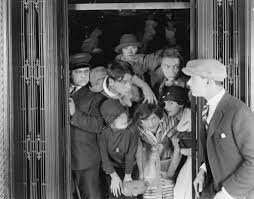JULY 24: TELL AN OLD JOKE DAY
“Knock-knock!”
“Who’s there?”
“Boo”
“Boo who?”
Don’t cry! National Tell an Old Joke Day is here! A day for keeping old jokes alive and kicking. Like every endangered species, old jokes need to be periodically revitalized. Spread cheer, share laughter, and reminisce about those old jokes everyone loves.
Some people say the joke was invented in Greece. Others even believe it originated in mythological legend by a person called Palamedes. Since he was also credited with inventing numbers, the alphabet, lighthouses, dice, and the practice of eating meals at regular intervals, we won’t hesitate to adopt this particular theory as the truth. Facts verify that the Greeks, were, in fact, a humorous lot. In the Athens of Demosthenes, there existed a comedians’ club called the Group of Sixty. They met in the Temple of Heracles and traded wisecracks. Apparently, Alexander the Great’s father, Philip II of Macedon, commissioned a book of their jokes. The very first joke book ever found was also from Greece. Titled “Philogelos,” or “Laughter-Lover,” it contains 264 jokes. The jokes in this book are famously spare and include gems like, “How shall I cut your hair?” a talkative barber asked a wag. “In silence!” the wag answered. The Ancient Romans, too, had their ‘jestbooks.’ The playwright Titus Maccius Plautus often referenced these in his plays, while the Roman historian Gaius Suetonius Tranquillus mentions a professor of the emperor Augustus, who compiled more than 150 jokes anthologies. “Philogelos” was misplaced during the Dark Ages and humor was kept alive only in the Arab world. As they spread around the world, so too did their satirical folktales and humor. As these folktales reached Europe, they split into two: one, the novel; the other, a shorter, more humorous anecdote. The early Renaissance brought the joke back with the help of one man — Poggio Bracciolini. Secretary to eight popes, this Italian humanist was a passionate bibliophile, traveling throughout Europe in search of lost works. This influenced his satirical writing, which was compiled in a book called “Facetiae.” Filled with 273 jests, bons mots, puns, and humorous anecdotes, this book was heavily influenced by another club called the Bugiale, which functioned as a jokes club of sorts. The first English jestbook even had a sample of Poggio’s jokes and, by the time Shakespeare came around, jestbooks were very popular. One more nudge was all the world needed to turn funny tales into a joke. It came when 28 jokes from “Philogelos” were accidentally published in an edition of “Commentary on the Golden Words of Pythagoras.” This mistake meant the ancient jokes soon circulated throughout Europe. Thanks to their popularity, jokes became shorter and punchier. The Georgian era brought gems like “Joe Miller’s Jests” — based on a notoriously gloomy London stage actor. By the 19th century, joke books began to be cleaned up and ribald language was removed. They became fillers in older forms of printed books and provided a source of enjoyment for anyone who read them.
JULY 25: MERRY-GO-ROUND DAY
Merry-Go-Round Day spotlights the fun ride known as a merry-go-round or carousel. A highlight of amusement parks, these circular rides are still widely popular not only across America but the world. The word carousel originated from the Italian Carosella and Spanish Carosella ("little battle"). The modern carousel emerged from early jousting traditions in Europe, introduced at the time of the Crusades from earlier Arab traditions. Knights would gallop in a circle while tossing balls from one to another, an activity requiring great skill and horsemanship.
By the 17th century, the balls had disappeared. Instead, riders had to spear small hanging rings from poles overhead and rip them off. Commoners began to play the game. Carousels soon sprung up at fairgrounds across Europe. At the Place du Carrousel in Paris, an early make-believe carousel was set up with wooden horses for children. By 1803 John Joseph Merlin had a carousel in his Mechanical Museum in London, where gentry and nobility liked to gather on winter evenings. It was connected to a "big musical instrument that played a fully orchestrated concerto." By the early 18th century carousels were being built and operated at various fairs and gatherings in central Europe and England, often powered by animals walking in a circle or people pulling a rope or cranking.
With large-scale immigration to America, the carousel came to the US. Mass production of carousels boomed with the Industrial Revolution, and they quickly spread around the country. Another benefit of this revolution was the extra leisure time people now had, making having fun on a carousel ride possible. Steam-power fully replaced animal power in the 19th century. Merry-go-rounds got bigger and heavier.
By the next century, carousels were being manufactured for amusement parks by many industries. The Great Depression put a lot of them out of business. As World War II came around, all resources were directed for war efforts, pushing the carousel to the wayside. They rebounded again as the economy improved, and units began to be made from synthetic materials.
JULY 26: BAGELFEST DAY
Okay, Bagelfest Day. Now, we usually rely on the good old Internet to describe a “special observance” day. For July 26, we take exception. We were delighted that July 26 is Bagelfest Day, but then learned it began with the folks from Lender’s Bagel. Hold on! No, no, no, no, no. No bagel should be frozen. Ever. Those people who have introduced the mass-produced, frozen, homogenized hideous object bearing the otherwise near-holy thing called a bagel have, yes, expanded the world of bagel-eaters while, at the same time, dealing the world of bagels a dastardly blow. We will include here the basics on Bagelfest Day. However, we also include a serious—and timely (July 11, 2023, no less) article from the “Serious Eats” website entitled “The Good Bagel Manifesto.” ( We encourage you to go above and beyond the usual and read this excellent piece, which celebrates the true bagel, rather than that thing pushed relentlessly and cynically on the bagel-eating public.) Okay, that’s our rant. (Now click here for the link to the article we suggested).
And on to Bagelfest:
National Bagelfest Day is celebrated on July 26 to recognize the scrumptious bread that is light and tasty. Did you know the bagel is the only bread that is boiled before being baked? Well, it’s facts like these and more that National Bagelfest Day is all about. All you need is an empty stomach, caffeine, and an endless interest in bagels. But first, a bit of history. Bagels are a bread product that originated in the Jewish communities of Poland. The spread of bagels across the world took time. Bagels did not reach England until the 19th century. They were brought to America by Polish Jews who immigrated. It is also important to note that the sizes of bagels have evolved over time and have greatly increased. For instance, an average bagel was three ounces in 1915 but weighed around six ounces by 2003.
JULY 27: BAGPIPE APPRECIATION DAY
Bagpipe Appreciation Day celebrates an ancient musical instrument that dates back thousands of years and has become a part of Scottish tradition. Bagpipes have been used during battles, funerals, parades, weddings, and royal occasions. Although central to Scottish identity — like kilts, haggis, and whiskey — bagpipes did not originate in Scotland. Rather, they have an ancient history tracing back to Mesopotamia, where shepherds were said to play them for leisure. There are speculations the pipes were in ancient Egypt, but no supporting evidence exists. A Hittite wall carving from around 1000 BC displays a bagpipe, suggesting that bagpipes were used in western Asia, too. Since the Hittites traded with Egypt, the instrument could have been passed on to them from the Egyptians. That leaves the Egyptians and the Hittites as the two possible inventors of the bagpipe.
The instrument was later introduced to the Greeks by the Romans when they conquered Greece. The bagpipes became popular in Britain after the Roman invasion. The first reference to the Scottish Highland bagpipes is from French history that mentions their use at the Battle of Pinkie in 1547. By the 18th century, they had become an icon of Scottish national identity. Bagpipes were for communication during battles to signal movements, attacks, and retreats. They were also played before a battle to inspire the army. When the Scottish uprising of 1745 failed, military training was banned, and bagpipes were no longer used for war. However, they were kept for other uses.
There are many types of bagpipes today. The most popular is Scotland’s Great Highland bagpipe. On Bagpipe Appreciation Day, we celebrate all variations of bagpipes and their contribution to culture and music. Though bagpipes are perhaps most commonly linked to the Scottish, the largest producer in the world of this aerophone instrument is Pakistan.
JULY 28: NATIONAL TALK IN AN ELEVATOR DAY
On the last Friday in July, National Talk in An Elevator Day encourages us to strike up a conversation with someone in an elevator. While many use this time to check a smart devices, this day points us in another direction. Whether we ride with a stranger or someone familiar to us, start a discussion. You might meet someone new. If you’re riding with someone you know, try to learn something new about them. Riding in an elevator can be a short, mundane experience inside a box. From another perspective, the short vertical trip could be a laughter break. Try out your stand-up comedy. Share your udderly moo-tivational cow puns you’ve been saving up. If comedy isn’t your style, break the silence with a miniature spelling bee. For example, see if you can get a consensus on how to spell consensus. Does everyone spell it with the correct number of Ss?
The best way to strike up a conversation in an elevator is to mention the national day. Did you know that elevators have been around since 200 B.C.? Elevators were invented by Archimedes, the famous Greek mathematician, scientist, and engineer. His invention included the usage of pulleys that were operated by either people or animals. Almost 800 years later, Ibn Khalaf al-Muradi, an Andalusian scientist, wrote about elevators in his book called “Book of Secrets.” The book described the anatomy of an elevator and how it can be used to lift animals to great heights. The modern-day elevator wasn’t invented until the 1800s. Elisha Graves Otis established the Otis Elevator Company in the mid-1850s. He debuted his invention in New York City at the Crystal Palace Convention. Before Otis’ invention, many avoided using an elevator due to safety concerns. The cables/ropes hoisting an elevator up and down would at times snap, bringing all of the elevator’s occupants down, too. This safety hazard was soon solved by Otis’ ingenious idea of installing spring technology into the elevator.
JULY 29: NATIONAL LASAGNA DAY
You don’t have to be Italian to celebrate National Lasagna Day. Tomato sauce, cheeses, meat, and vegetables — all separated by wide flat noodles: what’s not to love? Lasagna first showed up in Naples, Italy, during the Middle Ages and made it to America in the 19th century. Since then, Americans have made it all their own.
The word “lasagna” originated from ancient Greece. Essentially, the name stems from the word “laganon,” the earliest form of pasta: flattened sheets of dough sliced into thin strips. Of course, the original form was very different from the assembled lasagna dish we enjoy today. Layers of pasta slathered with sauce were present but without the essential Italian ingredients. A similar dish was commonly prepared in ancient Rome, called “lasanum,” which means pot or container in Latin. So, the word ‘lasagna’ actually comes from the method of cooking it, not the ingredients.
The lasagna cooked in Northern Italy uses flat noodles, while the noodles used in Southern Italy are rippled. The ingredients Italians use in the recipe depend on their family’s tradition and heritage.
JULY 30: PAPERBACK BOOK DAY
Paperback Book Day is an ode to the paperback bookend the journey it’s made since its inception. Many people think of the English publishing house Penguin when they think of paperback history. While it is true paperbacks’ popularity on a large scale took place when Penguin started with the idea in the 20th century, the history of paperbacks goes further back to the 17th century. European countries like Germany and France were already publishing stories and papers in the paperback-like format then. James Fenimore Cooper published frontier stories in a similar style. The publishing world’s “dime novels” and “penny dreadfuls” are, in fact, products of the same business phenomena.
But back to Penguin. During the Depression, its owner, Allen Lane, was going bankrupt in his publishing business. While waiting for his train, he browsed a station stall for something to read, but found nothing good except for magazines and low-quality paperback fiction. Aha! He came up with the idea of high-quality paperbacks, which would automatically raise profits by allowing more people to access good fiction at lower prices. From then on, paperbacks became a favorite with publishers and readers. Paperback Book Day is celebrated on July 30 because that was when Penguin published its first paperback. Paperback books became very popular during World War II. They were easy to carry around, and they were cheaper. After the war, paperback books became even more popular. Today, paperback books are still very popular.







